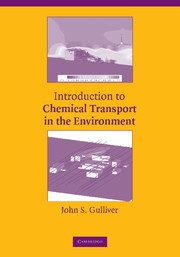Book contents
- Frontmatter
- Contents
- Preface
- 1 The Global Perspective on Environmental Transport and Fate
- 2 The Diffusion Equation
- 3 Diffusion Coefficients
- 4 Mass, Heat, and Momentum Transport Analogies
- 5 Turbulent Diffusion
- 6 Reactor Mixing Assumptions
- 7 Computational Mass Transport
- 8 Interfacial Mass Transfer
- 9 Air–Water Mass Transfer in the Field
- APPENDIXES
- References
- Subject Index
- Index to Example Solutions
2 - The Diffusion Equation
Published online by Cambridge University Press: 05 June 2012
- Frontmatter
- Contents
- Preface
- 1 The Global Perspective on Environmental Transport and Fate
- 2 The Diffusion Equation
- 3 Diffusion Coefficients
- 4 Mass, Heat, and Momentum Transport Analogies
- 5 Turbulent Diffusion
- 6 Reactor Mixing Assumptions
- 7 Computational Mass Transport
- 8 Interfacial Mass Transfer
- 9 Air–Water Mass Transfer in the Field
- APPENDIXES
- References
- Subject Index
- Index to Example Solutions
Summary
In this chapter, we will review various solution techniques for the diffusion equation, which is generally defined as the mass transport equation with diffusive terms. These techniques will be applied to chemical transport solutions in sediments. There are also a number of applications to chemical transport in biofilms. There are many other applications of the diffusion equation, including most of the topics of this text, but they require more background with regard to the physics of mixing processes, which will be addressed in later chapters.
What is mass (or chemical) transport? It is the transport of a solute (the dissolved chemical) in a solvent (everything else). The solute is the dissolvee and the solvent is the dissolver. There are liquids that are generally classified as solvents because they typically play that role in industry. Some examples would be degreasing and dry cleaning solvents, such as trichloroethylene. In environmental applications, these “solvents” are the solutes, and water or air is usually the solvent. In fact, when neither water nor air is the solvent, the general term nonaqueous phase liquid is applied. A nonaqueous phase liquid is defined as a liquid that is not water, which could be composed of any number of compounds.
The substance being transported can be either dissolved (part of the same phase as the water) or particulate substances. We will develop the diffusion equation by considering mass conservation in a fixed control volume.
Information
- Type
- Chapter
- Information
- Introduction to Chemical Transport in the Environment , pp. 16 - 54Publisher: Cambridge University PressPrint publication year: 2007
